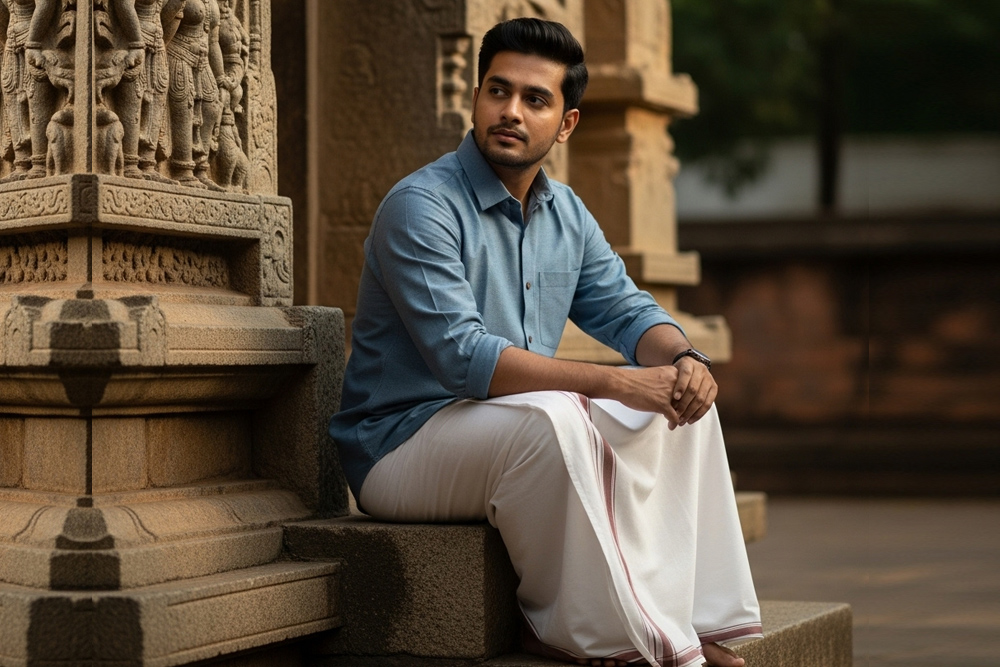Dhotis are more than just a piece of cloth in Indian culture; they’re a symbol of identity, simplicity, and tradition. Whether it is worn daily or reserved for special occasions, the dhoti holds an evergreen place in wardrobes across India. However, not all dhotis are made the same. When choosing one, you’ll likely come across two major types: handloom and powerloom dhotis.
At first glance, they may look similar. But a closer look reveals key differences in how they’re made, how they feel, and what they stand for. Here, we will see the major differences between handloom and powerloom dhotis to help you make an informed and meaningful choice.
What Is a Handloom Dhoti?
A handloom dhoti is woven by hand on a traditional loom made manually by skilled weavers. This method has been passed down through generations and is known for its cultural value.
Key Features:
- Artisanal Craft: Every dhoti is carefully woven by hand, making each piece unique.
- Natural Feel: Handloom dhotis are typically softer and more breathable due to the gentle weaving process.
- Eco-Friendly: They consume less electricity and are often made with natural dyes and fibres like cotton or khadi.
- Slight Imperfections: These add texture and reflect the human touch behind the cloth.
What Is a Powerloom Dhoti?
A powerloom dhoti is woven using electrically powered machines. This allows for faster production, uniformity, and a more affordable price point.
Key Features:
- Mass Production: Large quantities can be produced in less time, making them widely available.
- Consistent Quality: The fabric is more uniform and free of irregularities.
- Lower Cost: Powerloom dhotis are usually more budget-friendly.
- Less Craft Involved: While functional and durable, they may lack the charm and heritage of handwoven fabric.
Comparison: Handloom vs. Powerloom Dhotis
| Feature | Handloom Dhoti | Powerloom Dhoti |
| Weaving Method | Woven manually on traditional looms | Machine-woven using power looms |
| Look & Feel | Soft, breathable, natural texture | Smooth, consistent, slightly stiffer |
| Production Speed | Slow, limited quantity | Fast, high-volume |
| Uniqueness | Each piece is one-of-a-kind | Uniform and mass-produced |
| Price Range | Higher, due to labour and time | Lower, due to scale and automation |
| Cultural Value | Highly linked to tradition and heritage | Moderate—focused more on practicality |
| Environmental Impact | Low—less energy use, often eco-conscious | Higher machine use and industrial processing |
When to Choose a Handloom Dhoti
- Special Occasions: Weddings, pujas, festivals, or cultural events.
- Cultural Pride: When you want to support traditional artisans and handmade products.
- Comfort First: Ideal for long wear during summer or rituals due to its breathability.
- Sustainable Living: Perfect for those who prefer eco-friendly, slow fashion.
When to Choose a Powerloom Dhoti
- Daily Use: Great for regular wear, especially when cost and durability matter.
- Budget-Friendly Needs: Ideal if you’re looking for value-for-money options.
- Uniform Look: Suitable for formal settings or group events needing consistency.
- Easy Availability: Found widely in local markets and online stores.
The dhoti, whether handloom or powerloom, remains a garment of grace and cultural pride. But when you choose a handloom dhoti, you’re wearing more than fabric; you’re wearing history, skill, and soul. On the other hand, powerloom dhotis offer a practical, accessible way to keep the tradition alive in everyday life.
Both serve their purpose. The choice is yours, based on comfort, context, and the meaning you want your clothes to carry.

